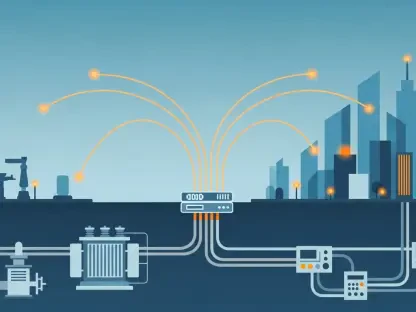The semiconductor industry in the United States is poised for a resurgence following a historic investment announcement from the White House. President Joe Biden has declared a strategic partnership with Intel, involving a $20 billion investment aimed at revitalizing the U.S. semiconductor sector. This development is a cornerstone of a broader effort under the CHIPS Act to reposition the country as a dominant force in global chip manufacturing. The move is expected to have wide-ranging implications for the economy, workforce, and national security.
Reviving U.S. Semiconductor Manufacturing
Intel’s Commitment and the CHIPS Act
The financial breakdown of Biden’s deal reveals a potent mix of grants and loans set to invigorate Intel’s Arizona operations. Specifically, $8.5 billion is earmarked as direct grants, while up to $11 billion will be facilitated through loans to support both the establishment of new manufacturing sites and the expansion of existing ones. This move personifies a concerted shift in strategic economic policy, reversing the tide on decades of outsourced production and placing the semiconductor supply chain firmly back onto American soil.Intel’s growth to a duo of new factories, alongside the upscaling of an existing one, may well mark the dawn of a semiconductor renaissance in the U.S. The implications go beyond addressing current supply chain vulnerabilities; they are instrumental in reinstating the nation as an innovation leader in this critical technology.
Prior Investments and Future Prospects
The technological landscape receives further fortification from prior CHIP Act allocations, with $1.5 billion strengthening GlobalFoundries and $162 million boosting Microchip Technology. Such investment injections serve as foundational pillars in the reconfiguration of a more robust and less fragmented production network.Looking ahead, other tech giants, such as Samsung and TSMC, are also cited as likely beneficiaries in this resurgence, though the specifics of future funding tranches remain meticulously under wraps. The overarching anticipation is that these subsequent investments will synergize with Intel’s influx, thereby bolstering the entire sector’s regeneration.
Economic and Workforce Impacts
Employment Opportunities Galore
The investment is forecasted to yield a prodigious number of jobs, spawning approximately 20,000 construction positions and 10,000 manufacturing roles. Notably, Phoenix is set to benefit from 3,000 new opportunities, where average annual salaries are anticipated to comfortably exceed the $100,000 mark. It’s not merely the quantity of positions that stands out; it’s the inclusive nature of the recruitment drive that underscores Intel’s commitment. By potentially skipping the college degree requirement for certain roles, the doors are swung wide open for a diverse array of applicants to step into high-paying jobs.Intel’s labor blueprint interlocks with the Biden administration’s wider employment philosophy—a revival of the middle class through accessible, lucrative jobs within a cornerstone industry. It’s a message reverberating with hopeful resonance amongst communities longing for economic revitalization.
Education and Workforce Development Initiatives
To underpin the expected employment surge, a comprehensive workforce development initiative is unwrapped. This initiative encompasses collaborations with community colleges and universities, nurturing a pipeline of talent steeped in the skills that will shape tomorrow’s semiconductor industry. The scheme heralds a two-pronged advantage; not only does it offer a trajectory for continuous innovation within the sector, but it also features as a vital cog in the machinery that’s set to drive forward personal and regional economic prosperity. Through these educational partnerships, a workforce will be galvanized, ready to excel in a rejuvenated industry.
Innovation, Security, and Sustainability
Technological Sovereignty and National Security
Semiconductors are pivotal for both everyday consumer electronics and complex military systems. The Biden administration has accentuated this duality, highlighting the pressing need for U.S. leadership in semiconductor production. It’s a question of technological sovereignty—securing dependable access to the building blocks of modern devices is tantamount to holding the reins of national security.The ambition is staked high, with the U.S. aiming for a 20% share of the world’s cutting-edge chip production by the decade’s end. Achieving this would ensure the technological supremacy needed for advanced military capabilities and would also buttress the nation’s autonomy in the face of geopolitical uncertainties.
Environmental Responsibility and Sustainability
True to a promise of responsible growth, Intel sets its sights on achieving net-zero greenhouse gas emissions by 2040. This ambition forms a critical thread in the fabric of the semiconductor industry’s future, intertwining the need for innovation with environmental stewardship. As such investments take flight, they carry with them the imperative for sustainable practices, ensuring that the industry’s boom does not become a bane for the planet. The semiconductor revival is thus being architected on principles that respect our global environmental responsibilities.
A Strategic Vision for the Future
Reinforcing Economic Prosperity
The Intel deal carries the transformative potential to initiate a new era of American economic dynamism, serving as a catalyst for technological advancement and growth. By rekindling its semiconductor capabilities, the United States stands to gain strategic advantages in the global marketplace, fostering an ecosystem where innovation thrives. This, in turn, facilitates the country’s pivot towards an economic prosperity that is both inclusive and sustainable.
Securing a Competitive Edge
The Intel investment embodies a long-term strategic vision where technological sovereignty is paramount. It aims to establish a resilient foundation for the U.S. semiconductor industry, positioning the country to confront future economic challenges with robustness and maintain a technological edge on the global stage. Herein lies the crux of this grand endeavor: to ensure America is not just participating in the race for tech supremacy but is indeed leading the charge.









